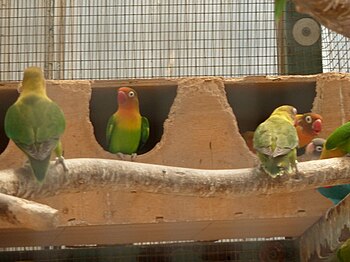 |
| Lovebirds (Agapornis) at Zapari zoo, Tel Aviv, Israel (Photo credit: Wikipedia) |
The mating act itself will be conducted by your lovebirds on their perch, and to facilitate the process you will need to provide a steady perch that the birds can comfortably grip whilst they engage in the act of mating.
Once your bird has laid a clutch of eggs you will be eagerly awaiting the hatching process. Do not be surprised if all the eggs do not hatch as this is common. The next most common problem after un-hatched eggs is when young chicks do not have the ability to walk well and suffer splayed legs. To avoid this make sure that the nest box flooring is of a suitable flooring that the parrots can walk on.
An experienced breeder will manage these two issues and keep a watchful eye on the parents as they manage the feeding of their young by regurgitating food and giving it to them. To help this process you need to provide foods that are easy to process and regurgitate and ample supplies of water.
Of course, the areas covered in this three-part series have been quite basic and we encourage you to do a lot more research before starting on the exciting journey of breeding parrots.
has articles on all aspects of parrot care, and is a great read for those that keep parrots as pets.
Article Source: EzineArticles
|

No comments:
Post a Comment